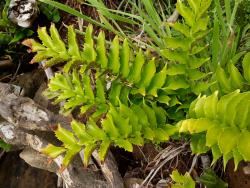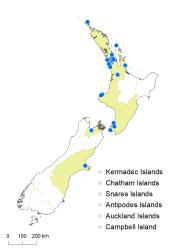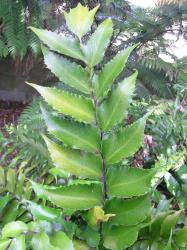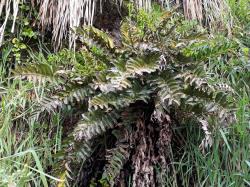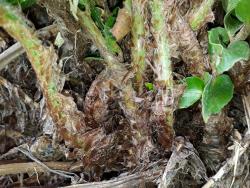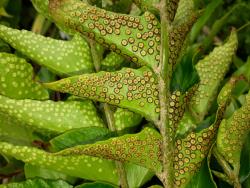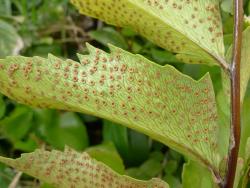- ≡ Polypodium falcatum L.f., Suppl. Pl. 446 (1782)
- ≡ Aspidium falcatum (L.f.) Sw., J. Bot. (Schrader) 1800(2): 31 (1801)
- ≡ Dryopteris falcata (L.f.) Kuntze, Revis. Gen. Pl. 2, 812 (1891)
- ≡ Polystichum falcatum (L.f.) Diels in Engler & Prantl, Nat. Pflanzenfam. 1(4), 194 (1899)
- ≡ Phanerophlebia falcata (L.f.) Copel., Gen. Fil. 111 (1947)
Rhizomes erect, densely scaly. Rhizome scales ovate, 5–8 mm long, 0.8–1.4 mm wide, pale brown or chestnut-brown, concolorous or darker towards the centre, margins irregularly toothed, apices acuminate. Fronds 200–1100 mm long. Stipes 70–450 mm long, pale or chestnut-brown, densely scaly, especially proximally; scales elliptic, chestnut-brown, up to 20 mm long and 6 mm wide, irregularly toothed or fimbriate on margins, acuminate. Rachises pale brown, sulcate, scaly; scales abundant throughout, with a mixture of narrowly ovate to hair-like, pale brown scales. Laminae 1‑pinnate, narrowly ovate or narrowly elliptic, 120–770 mm long, 70–250 mm wide, glossy dark green adaxially, paler green abaxially, coriaceous, bearing hair-like scales on abaxial costae and laminae, almost glabrous adaxially. Primary pinnae in 5–17 pairs below terminal pinna, widely spaced especially proximally, ovate distally, ovate or oblong proximally, falcate; the longest at or below the middle, 50–145 mm long, 20–50 mm wide, apices acuminate, bases stalked, lobed acroscopically, margins irregularly toothed. Veins reticulate. Sori round, in several rows either side of costa; indusia round, 0.9–1.3 mm diameter, with dark centres, glabrous.
Cyrtomium falcatum can be recognised by its terrestrial habit, erect rhizome, 1-pinnate scaly frond, irregularly toothed and falcate pinnae, reticulate venation, and sori protected by round indusia that are arranged in several rows either side of the midrib.
North Island: Northland, Auckland, Taranaki, Southern North Island.
South Island: Sounds-Nelson, Canterbury.
Altitudinal range: 0–60 m.
Cyrtomium falcatum is naturalised in the North Island at Spirits Bay, on islands in the Hauraki Gulf, and around Auckland, Coromandel Peninsula, Hamilton, New Plymouth, Waikanae and Wellington. It has also been recorded growing in the South Island in Nelson and as a weed in a glasshouse at Governors Bay, Port Hills.
Occurs naturally in China, Japan and south-east Asia (Zhang & Barrington 2013), but is introduced in Europe (Tutin et al. 1964; Page 1982), North America (Smith 1993), Hawai‘i (Palmer 2003), Reunion, southern Africa (Roux 2009), and Australia (Jones 1998).
Cyrtomium falcatum occurs in lowland habitats, often near the sea, growing on cliffs, clay banks, rocky ground, sandy slopes, stream banks, in open grassland, among Phormium, and under scrub, pōhutukawa and willows. It also occurs in urban environments, growing on retaining walls, mortar, and among builder’s rubble.
Brownsey (1981). Voucher CHR 83376, 1952.
No chromosome count has been reported for New Zealand plants, but sexually reproducing diploid and tetraploid cytotypes, and an apomictic triploid, are known in Asia (Zhang & Barrington 2013).



